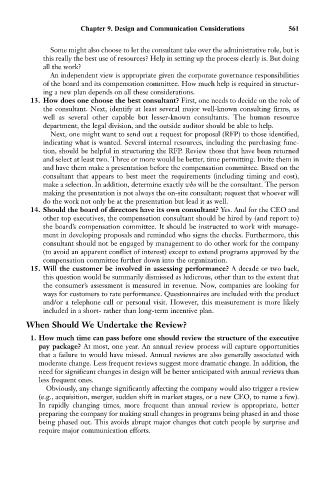Page 575 - Bruce Ellig - The Complete Guide to Executive Compensation (2007)
P. 575
Chapter 9. Design and Communication Considerations 561
Some might also choose to let the consultant take over the administrative role, but is
this really the best use of resources? Help in setting up the process clearly is. But doing
all the work?
An independent view is appropriate given the corporate governance responsibilities
of the board and its compensation committee. How much help is required in structur-
ing a new plan depends on all these considerations.
13. How does one choose the best consultant? First, one needs to decide on the role of
the consultant. Next, identify at least several major well-known consulting firms, as
well as several other capable but lesser-known consultants. The human resource
department, the legal division, and the outside auditor should be able to help.
Next, one might want to send out a request for proposal (RFP) to those identified,
indicating what is wanted. Several internal resources, including the purchasing func-
tion, should be helpful in structuring the RFP. Review those that have been returned
and select at least two. Three or more would be better, time permitting. Invite them in
and have them make a presentation before the compensation committee. Based on the
consultant that appears to best meet the requirements (including timing and cost),
make a selection. In addition, determine exactly who will be the consultant. The person
making the presentation is not always the on-site consultant; request that whoever will
do the work not only be at the presentation but lead it as well.
14. Should the board of directors have its own consultant? Yes. And for the CEO and
other top executives, the compensation consultant should be hired by (and report to)
the board’s compensation committee. It should be instructed to work with manage-
ment in developing proposals and reminded who signs the checks. Furthermore, this
consultant should not be engaged by management to do other work for the company
(to avoid an apparent conflict of interest) except to extend programs approved by the
compensation committee further down into the organization.
15. Will the customer be involved in assessing performance? A decade or two back,
this question would be summarily dismissed as ludicrous, other than to the extent that
the consumer’s assessment is measured in revenue. Now, companies are looking for
ways for customers to rate performance. Questionnaires are included with the product
and/or a telephone call or personal visit. However, this measurement is more likely
included in a short- rather than long-term incentive plan.
When Should We Undertake the Review?
1. How much time can pass before one should review the structure of the executive
pay package? At most, one year. An annual review process will capture opportunities
that a failure to would have missed. Annual reviews are also generally associated with
moderate change. Less frequent reviews suggest more dramatic change. In addition, the
need for significant changes in design will be better anticipated with annual reviews than
less frequent ones.
Obviously, any change significantly affecting the company would also trigger a review
(e.g., acquisition, merger, sudden shift in market stages, or a new CEO, to name a few).
In rapidly changing times, more frequent than annual review is appropriate, better
preparing the company for making small changes in programs being phased in and those
being phased out. This avoids abrupt major changes that catch people by surprise and
require major communication efforts.

